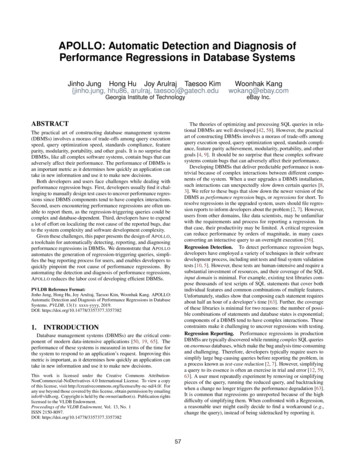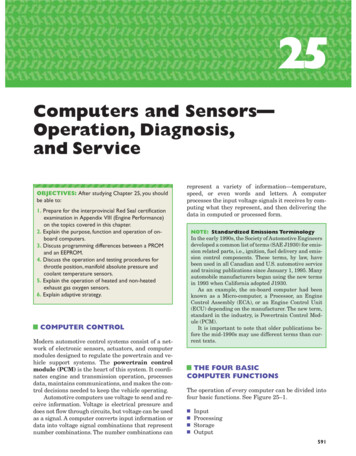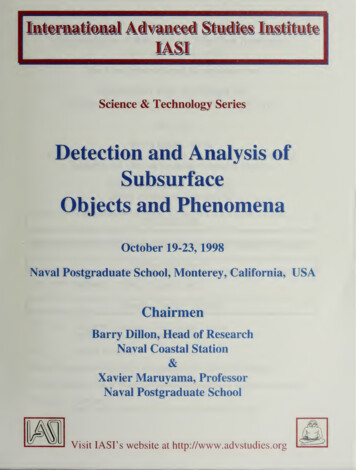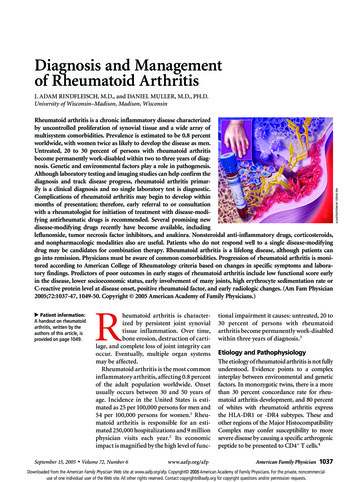
Transcription
APOLLO: Automatic Detection and Diagnosis ofPerformance Regressions in Database SystemsJinho Jung Hong Hu Joy Arulraj Taesoo Kim{jinho.jung, hhu86, arulraj, taesoo}@gatech.eduWoonhak Kangwokang@ebay.comGeorgia Institute of TechnologyeBay Inc.ABSTRACTThe theories of optimizing and processing SQL queries in relational DBMSs are well developed [42, 58]. However, the practicalart of constructing DBMSs involves a morass of trade-offs amongquery execution speed, query optimization speed, standards compliance, feature parity achievement, modularity, portability, and othergoals [4, 9]. It should be no surprise that these complex softwaresystems contain bugs that can adversely affect their performance.Developing DBMSs that deliver predictable performance is nontrivial because of complex interactions between different components of the system. When a user upgrades a DBMS installation,such interactions can unexpectedly slow down certain queries [8,3]. We refer to these bugs that slow down the newer version of theDBMS as performance regression bugs, or regressions for short. Toresolve regressions in the upgraded system, users should file regression reports to inform developers about the problem [2, 7]. However,users from other domains, like data scientists, may be unfamiliarwith the requirements and process for reporting a regression. Inthat case, their productivity may be limited. A critical regressioncan reduce performance by orders of magnitude, in many casesconverting an interactive query to an overnight execution [56].Regression Detection. To detect performance regression bugs,developers have employed a variety of techniques in their softwaredevelopment process, including unit tests and final system validationtests [10, 5]. However, these tests are human-intensive and require asubstantial investment of resources, and their coverage of the SQLinput domain is minimal. For example, existing test libraries compose thousands of test scripts of SQL statements that cover bothindividual features and common combinations of multiple features.Unfortunately, studies show that composing each statement requiresabout half an hour of a developer’s time [63]. Further, the coverageof these libraries is minimal for two reasons: the number of possible combinations of statements and database states is exponential;components of a DBMS tend to have complex interactions. Theseconstraints make it challenging to uncover regressions with testing.Regression Reporting. Performance regressions in productionDBMSs are typically discovered while running complex SQL querieson enormous databases, which make the bug analysis time-consumingand challenging. Therefore, developers typically require users tosimplify large bug-causing queries before reporting the problem, ina process known as test-case reduction [2, 7]. However, simplifyinga query to its essence is often an exercise in trial and error [12, 59,63]. A user must repeatedly experiment by removing or simplifyingpieces of the query, running the reduced query, and backtrackingwhen a change no longer triggers the performance degradation [63].It is common that regressions go unreported because of the highdifficulty of simplifying them. When confronted with a Regression,a reasonable user might easily decide to find a workaround (e.g.,change the query), instead of being sidetracked by reporting it.The practical art of constructing database management systems(DBMSs) involves a morass of trade-offs among query executionspeed, query optimization speed, standards compliance, featureparity, modularity, portability, and other goals. It is no surprise thatDBMSs, like all complex software systems, contain bugs that canadversely affect their performance. The performance of DBMSs isan important metric as it determines how quickly an application cantake in new information and use it to make new decisions.Both developers and users face challenges while dealing withperformance regression bugs. First, developers usually find it challenging to manually design test cases to uncover performance regressions since DBMS components tend to have complex interactions.Second, users encountering performance regressions are often unable to report them, as the regression-triggering queries could becomplex and database-dependent. Third, developers have to expenda lot of effort on localizing the root cause of the reported bugs, dueto the system complexity and software development complexity.Given these challenges, this paper presents the design of A POLLO,a toolchain for automatically detecting, reporting, and diagnosingperformance regressions in DBMSs. We demonstrate that A POLLOautomates the generation of regression-triggering queries, simplifies the bug reporting process for users, and enables developers toquickly pinpoint the root cause of performance regressions. Byautomating the detection and diagnosis of performance regressions,A POLLO reduces the labor cost of developing efficient DBMSs.PVLDB Reference Format:Jinho Jung, Hong Hu, Joy Arulraj, Taesoo Kim, Woonhak Kang. APOLLO:Automatic Detection and Diagnosis of Performance Regressions in DatabaseSystems. PVLDB, 13(1): xxxx-yyyy, 2019.DOI: TIONDatabase management systems (DBMSs) are the critical component of modern data-intensive applications [50, 19, 65]. Theperformance of these systems is measured in terms of the time forthe system to respond to an application’s request. Improving thismetric is important, as it determines how quickly an application cantake in new information and use it to make new decisions.This work is licensed under the Creative Commons AttributionNonCommercial-NoDerivatives 4.0 International License. To view a copyof this license, visit http://creativecommons.org/licenses/by-nc-nd/4.0/. Forany use beyond those covered by this license, obtain permission by emailinginfo@vldb.org. Copyright is held by the owner/author(s). Publication rightslicensed to the VLDB Endowment.Proceedings of the VLDB Endowment, Vol. 13, No. 1ISSN 2150-8097.DOI: https://doi.org/10.14778/3357377.335738257
Regression Diagnosis. Even if a user successfully files a minimalbug report, it is still challenging for developers to identify the rootcause of the problem [45, 64]. Currently, a developer may manuallyexamine the control-flow and data-flow of the system, or use aperformance profiler to determine where the system is spending itscomputational resources. However, such tools will not highlightwhy these resources are being spent [53, 54]. A recent study showsthat a developer usually invests more than 100 days on average, asignificant amount of effort, on diagnosing a bug [64] 1 .Prior research on the automatic bug detection in DBMS has focused on correctness bugs. The R AGS automated testing system,designed by the Microsoft SQL Server testing group, stochastically generates valid SQL queries and compares the results for thegenerated queries on diverse DBMSs [63]. While this techniqueuncovered several correctness bugs, it suffers from three limitations.First, it is not tailored for detecting performance regression bugs.It often misclassifies queries that do not suffer from performanceregression as candidates for reporting. Second, it does not assistdevelopers with the Regression-diagnosis process, leading to longerbug-fixing periods. Finally, the test-case reduction algorithm employed in R AGS is not effective on complex SQL queries (§7.2).This paper addresses these challenges by developing techniquesfor automatically detecting Performance regressions, minimizing thequeries for bug-reporting, and assisting developers with bug diagnosis. We implemented these techniques in a prototype, calledA POLLO. We demonstrate that A POLLO simplifies the Regression reporting process for users and enables developers to quicklypinpoint the root cause of performance regressions. We evaluateA POLLO on two DBMSs: SQLite and PostgreSQL [6, 1]. A POLLOdiscovered 10 previously unknown performance regression bugs,where seven of them have been acknowledged by developers. Amongthese discovered regressions, it accurately pinpoints the root causesfor eight bugs. By automating the detection and diagnosis of regressions, A POLLO reduces the labor cost of developing DBMSs.In summary, we make the following contributions: We introduce a technique to automatically detect performanceregression bug in DBMSs using domain-specific fuzzing (§4). We propose an algorithm to automatically reduce queries forreporting regression bugs (§5). We formulate a technique to automatically locate the root causeof regressions through bisecting and statistical debugging (§6). We demonstrate the utility of our automated techniques for detecting, reporting, and diagnosing Performance regressions ontwo popular DBMSs: SQLite and PostgreSQL (§7).We will release the source code of our system at: https://github.com/sslab-gatech/apollo.2.DBMS to a new version, a critical regression bug can slow downcertain queries by orders of magnitude, in many cases converting aninteractive query to an overnight one [56, 21, 8, 3].SELECT R0.S DIST 06 FROM PUBLIC.STOCK AS R0WHERE (R0.S W ID CAST(LEAST(0, 1) AS INT8));Example 1. Impact on Runtime Performance. Consider theSQL query above derived from the TPC-C benchmark [15]. Whenwe run this query on the latest version of PostgreSQL v11.1 (maintained since NOV 2018), it takes 15800 more time to executecompared to that taken on an earlier version v9.5.0 (maintainedsince JAN 2016). We attribute this performance regression to theinterplay between the query optimizer that overestimates the numberof rows in a table and a recently introduced policy for choosing thescan algorithm. Due to the misestimation, the optimizer in the latestversion selects an expensive sequential scan algorithm, while inthe earlier version, it picks the cheaper bitmap scan instead. Thisexample illustrates the impact of performance regressions on userproductivity. We defer a detailed discussion of this bug to §7.3.1.SELECT R0.NO O ID FROM MAIN.NEW ORDER AS R0WHERE EXISTS (SELECT R1.O OL CNT FROM MAIN.OORDER AS R1WHERE EXISTS (SELECT R2.H C ID FROM MAIN.HISTORY AS R2WHERE (R0.NO W ID IS NOT NULL) AND (R2.H C ID IS ’A’)));Example 2. Debugging Complexity. The SQL query abovetakes two hours to complete on the latest version of SQLite v3.27.2(FEB 2019), while an earlier version of SQLite v3.23.0 (APR 2018)completes this query in an hour. The commit that introduced thisregression contains 242 lines of additions and 116 lines of deletions,spanning 20 files. The developer has to spend a significant amountof time to pinpoint the root cause of this regression even if sheknows the bug is introduced in this commit. This example illustratesthe complexity of debugging performance regressions. We defer adetailed discussion of this regression to §6.2.2.2.2MOTIVATION & BACKGROUNDIn this section, we first demonstrate the necessity of the detectionand automatic diagnosis of performance regressions in DBMSs.Then, we present the challenges to achieve these goals and brieflydiscuss our corresponding solutions. At the end, we provide anoverview of greybox fuzzing and statistical debugging techniques.2.1Challenges & Our ApproachesThe oft-repeated struggles of DBMS users and developers withdiscovering, reporting, and diagnosing performance regressionsmotivate the need for an automated toolchain to assist with thesekey tasks. Unfortunately, prior research on automated bug detectionin DBMSs focused on functionality-related bugs [63]. For example,the R AGS system cannot uncover any performance regression orhelp diagnose the root cause. We develop A POLLO to tackle thefollowing challenges to provide automatic performance regressiondetection, minimization, and diagnosis in DBMS systems:Finding Regressions. We stochastically generates SQL statements for uncovering performance regressions using fuzzing [34,40, 44]. This technique consists of bombarding a system with manyrandomly generated inputs. Researchers have successfully used itto find security vulnerabilities and correctness bugs [70, 67]. Unlike those bugs, validating performance regressions is challengingbecause the ground truth of the regression is unclear and may beheavily affected by the execution environment. We tackle theseproblems by applying a set of validation checks, incorporating thefeedback from DBMS developers, to reduce false positives.Reducing Queries. When a regression is discovered, the nextchallenge is for users to report it [7, 2]. As the queries are usuallylarge and spans multiple files, users have to perform query reductionto minimize the report. However, manual query reduction is timeconsuming and challenging, especially for users who are non-expertsin the domain of databases [12, 59]. We solve this problem byiteratively distilling a regression-causing statement to its essence.This takes out as many elements of the statement as possible whileMotivating ExamplesDBMSs are enigmatic for many users, as their performance ishighly dependent on the complex interactions among many components. These interactions can trigger performance regressions thatlimit the users’ productivity. For example, when a user upgrades the1The authors attribute the delayed diagnosis process to: (1) communication delays between bug reporters and developers, (2) inabilityto reproduce the symptoms, and (3) lack of good diagnosis tools.58
t ❸ Input ❹ Execution ❻ crashedMutationSelection& Monitortestcasesv1v2❺ Interesting test Figure 2: Architecture of A POLLO. It takes in two versions of one DBMS,and produces a set of performance regression reports. Internally, A POLLOmutates SQL queries to trigger significant speed difference. Then it minimizes the bug-triggering queries and performs diagnosis on the regression.Figure 1: Overview of greybox fuzzing. A fuzzer keeps mutating knowninputs to genera
pinpoint the root cause of performance regressions. We evaluate APOLLO on two DBMSs: SQLite and PostgreSQL [6,1]. APOLLO discovered 10 previously unknown performance regression bugs, where seven of them have been acknowledged by developers. Among these discovered regressions, it accurately pinpoints the root causes for eight bugs. By automating the detection and diagnosis of











